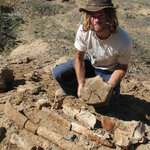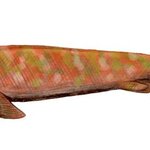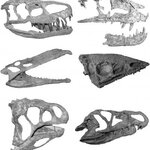Paleontology

One of the smallest dinosaur skulls ever discovered has been identified and described by a team of scientists from London, Cambridge and Chicago. The skull would have been only 45 millimeters (less than two inches) in length. It belonged to a very young Heterodontosaurus, an early dinosaur. This juvenile weighed about 200 grams, less than two sticks of butter.
In the Fall issue of the Journal of Vertebrate Paleontology, the researchers describe important findings from this skull that suggest how and when the ornithischians, the family of herbivorous dinosaurs that includes…

Contrary to popular belief, polar dinosaurs may not have traveled nearly as far as originally thought when making their bi-annual migration.
University of Alberta researchers Phil Bell and Eric Snively have suggested that while some dinosaurs may have migrated during the winter season, their range was significantly less than previously thought, which means their treks were shorter. Bell and Snively's findings were recently published in Alcheringa: An Australasian Journal of Paleontology. Phil Bell holding a vertebra of a 70-million-year-old Saurolophus.
The idea that these animals may…

University of Utah geologists identified an amazing concentration of dinosaur footprints that they call “a dinosaur dance floor,” located in a wilderness on the Arizona-Utah border where there was a sandy desert oasis 190 million years ago.
The three-quarter-acre site – which includes rare dinosaur tail-drag marks – provides more evidence there were wet intervals during the Early Jurassic Period, when the U.S. Southwest was covered with a field of sand dunes larger than the Sahara Desert.
Located within the Vermilion Cliffs National Monument, the “trample surface” (or “trampled surface”) has…

Welcome. Can you stay for our Infinite Footprints Tour?
The beat is on. Do you remember your first thoughts of footprints?
I do. Animal tracks in deep winter snow. Not as intriguing as the Anasazi footprints on volcanic rocks.
Those ancient footmarks would not be regarded as the oldest in the world. Here is the oldest as known today:
"At approximately 570 million years old, this new fossil not only provides the earliest suggestion of animals walking on legs, but it also shows that complex animals were alive on Earth before the Cambrian."(1)
That animal left its footprints of little dots in…

The fossilized trail of an aquatic creature suggests that animals walked using legs at least 30 million years earlier than had been thought. The tracks, two parallel rows of small dots, each about 2 millimeters in diameter, date back some 570 million years, to the Ediacaran period.
The Ediacaran preceded the Cambrian period, the time when most major groups of animals first evolved.
Scientists once thought that it was primarily microbes and simple multicellular animals that existed prior to the Cambrian, but that notion is changing, explained Loren Babcock, professor of earth sciences at Ohio…

The remains of a 30-foot-long predatory dinosaur discovered along the banks of Argentina's Rio Colorado is helping to unravel how birds evolved their unusual breathing system.
Birds have a breathing system that is unique among land animals. Instead of lungs that expand, birds have a system of bellows, or air sacs, which help pump air through the lungs. This novel feature is the reason birds can fly higher and faster than bats, which, like all mammals, expand their lungs in a less efficient breathing process.
The discovery, announced at a news conference in Mendoza, Argentina, builds on…

This kind of Mother Goose is no fairy tale. A 50 million year old skull reveals that huge birds with a 5 meter wingspan once skimmed across the waters that covered what is now London, Essex and Kent. These giant ocean-going relatives of ducks and geese also had a rather bizarre attribute for a bird: their beaks were lined with bony-teeth.
Described today in the journal Palaeontology, the skull belongs to Dasornis, a bony-toothed bird, or pelagornithid, and was discovered in the London Clay, which lies under much of London, Essex and northern Kent in SE England. The occurrence of bony-toothed…

Tetrapods, the first four-legged land animals, have also been considered the first organisms that had fingers and toes but researchers at Uppsala University say that is not the case.
Using medical x-rays, they found rudiments of fingers in the fins in fossil Panderichthys, the “transitional animal,” which indicates that rudimentary fingers developed considerably earlier than was previously thought.
Our fish ancestors evolved into the first four-legged animals, tetrapods, 380 million years ago. They are the forerunners of all birds, mammals, crustaceans, and batrachians (Editor - and reptiles…

When the world's land was congealed in one supercontinent 240 million years ago, Antarctica wasn't the forbiddingly icy place it is now. But paleontologists have found a previously unknown amphibious predator species that probably still made it less than hospitable.
The species, named Kryostega collinsoni, is a temnospondyl, a prehistoric amphibian distantly related to modern salamanders and frogs. K. collinsoni resembled a modern crocodile, and probably was about 15 feet in length with a long and wide skull even flatter than a crocodile's.
The term "Kryostega" translates to 'frozen' and '…

Depending on if you are pro- or con- on the dinosaur issue, you have good or bad things to say. While dinosaurs dominated land for well over 100 million years and evolved into numerous species, they still got snuffed out rather suddenly 65 million years ago. epitomize both success and failure. Failure because they went extinct suddenly 65 million years ago; success because they dominated terrestrial ecosystems for well over 100 million years evolving into a wide array of species that reached tremendous sizes.
University of Bristol researchers Steve Brusatte and Professor Mike Benton say it…